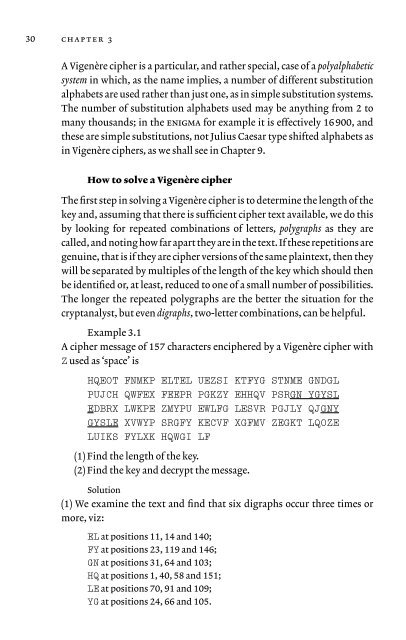Code and ciphers: Julius Caesar, the Enigma and the internet
Code and ciphers: Julius Caesar, the Enigma and the internet
Code and ciphers: Julius Caesar, the Enigma and the internet
You also want an ePaper? Increase the reach of your titles
YUMPU automatically turns print PDFs into web optimized ePapers that Google loves.
30<br />
chapter 3<br />
A Vigenère cipher is a particular, <strong>and</strong> ra<strong>the</strong>r special, case of a polyalphabetic<br />
system in which, as <strong>the</strong> name implies, a number of different substitution<br />
alphabets are used ra<strong>the</strong>r than just one, as in simple substitution systems.<br />
The number of substitution alphabets used may be anything from 2 to<br />
many thous<strong>and</strong>s; in <strong>the</strong> enigma for example it is effectively 16 900, <strong>and</strong><br />
<strong>the</strong>se are simple substitutions, not <strong>Julius</strong> <strong>Caesar</strong> type shifted alphabets as<br />
in Vigenère <strong>ciphers</strong>, as we shall see in Chapter 9.<br />
How to solve a Vigenère cipher<br />
The first step in solving a Vigenère cipher is to determine <strong>the</strong> length of <strong>the</strong><br />
key <strong>and</strong>, assuming that <strong>the</strong>re is sufficient cipher text available, we do this<br />
by looking for repeated combinations of letters, polygraphs as <strong>the</strong>y are<br />
called, <strong>and</strong> noting how far apart <strong>the</strong>y are in <strong>the</strong> text. If <strong>the</strong>se repetitions are<br />
genuine, that is if <strong>the</strong>y are cipher versions of <strong>the</strong> same plaintext, <strong>the</strong>n <strong>the</strong>y<br />
will be separated by multiples of <strong>the</strong> length of <strong>the</strong> key which should <strong>the</strong>n<br />
be identified or, at least, reduced to one of a small number of possibilities.<br />
The longer <strong>the</strong> repeated polygraphs are <strong>the</strong> better <strong>the</strong> situation for <strong>the</strong><br />
cryptanalyst, but even digraphs, two-letter combinations, can be helpful.<br />
Example 3.1<br />
A cipher message of 157 characters enciphered by a Vigenère cipher with<br />
Z used as ‘space’ is<br />
HQEOT FNMKP ELTEL UEZSI KTFYG STNME GNDGL<br />
PUJCH QWFEX FEEPR PGKZY EHHQV PSRGN YGYSL<br />
EDBRX LWKPE ZMYPU EWLFG LESVR PGJLY QJGNY<br />
GYSLE XVWYP SRGFY KECVF XGFMV ZEGKT LQOZE<br />
LUIKS FYLXK HQWGI LF<br />
(1) Find <strong>the</strong> length of <strong>the</strong> key.<br />
(2) Find <strong>the</strong> key <strong>and</strong> decrypt <strong>the</strong> message.<br />
Solution<br />
(1) We examine <strong>the</strong> text <strong>and</strong> find that six digraphs occur three times or<br />
more, viz:<br />
EL at positions 11, 14 <strong>and</strong> 140;<br />
FY at positions 23, 119 <strong>and</strong> 146;<br />
GN at positions 31, 64 <strong>and</strong> 103;<br />
HQ at positions 1, 40, 58 <strong>and</strong> 151;<br />
LE at positions 70, 91 <strong>and</strong> 109;<br />
YG at positions 24, 66 <strong>and</strong> 105.

















